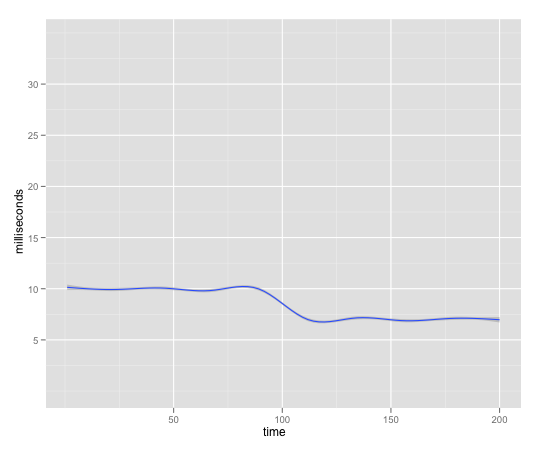This was written by Adam Fletcher (@adamfblahblah
One task that often falls on the lonely sysadmin is load testing. In this article I'm going to talk about some philosophies and processes I used when doing load testing in my past roles.
I'm going to focus on testing the server side. There's a lot of articles on how to optimize the client side experience, and it is very important that you are aware of both the client side and server side tuning changes so that you can give the customer the best experience.
Use Science

Science
(credit to XKCD. Buy the shirt!)
What I mean by that is that load testing is really experimentation. You're testing a hypothesis: Is setup A better than setup B? Develop your hypothesis, experiment, and measurements, and make conclusions based on data, not feelings. Don't forget that you need to control as many variables as possible. Don't test on your VMs or your staging server that the customer is also using.
Have Defined Targets
You can't determine if your architecture scales/is fast enough/can handle traffic during a disaster/won't crash when you launch/etc. without have something measurable that determines success. For example, instead of saying "make each page load in 400 milliseconds", it is better to say something like "Every page load must have also resources loaded within an average 400 milliseconds with a standard deviation of 25 milliseconds with 1000 clients performing actions every X seconds on Y series of pages." You will then know when you are done load testing because all the measurements you are taking show you have achieved success.
Scale First
If the Y axis is latency and the X axis is number of workers, then scaling is keeping Y constant while you increase X to infinity. This is much harder than keeping the number of workers constant and lowering latency. The first thing to look at during load testing is the shape of your latency curve as load increases. Keep that curve flat and you're most of the way there.
Understand Your Traffic
If you're already suffering a load problem in production, great! Track the pages being requested and the path of the requests through your system. Use a tool like Google Analytics to get a picture of the diversity of the pages hit and the flow your users take through the product. You'll want to be able to model those flows in your load generation software.
For example, an online store may have a few different paths users commonly take through the system: arrive at the home page organically, search for a product, add to a cart, and check out; arrive at a special landing page for a sale, add to cart, checkout; arrive at the home page organically and use the customer services features; etc. If you viewed this store's traffic at single point in time you could divide your simultaneous traffic up by percentage of pages hit: at a point in time, 30% of the requests are to /search, 20% are to /checkout, 40% are to /, and finally 10% are to /customer-service. This is the model you should use for load generation.
Your traffic also follows patterns that depend on the time of day. With the advent of (somewhat) elastic capacity allocation, you can model these usage patterns and adjust your capacity to fit the pattens of usage.
Furthermore, you need to be aware of client side changes such as allowing your users to use HTTP pipelining or inlining Javascript versus loading the Javascript in another HTTP request. Making the server scale requires you understanding the client.
Know Your Resource Limits
You don't have infinite computing power. You don't have infinite money. Most importantly, you don't have infinite time. Be smart about how you use that time.
It's expensive to have people do all the load testing science we're talking about in this article. With a little thought, you can probably guess where your bottleneck is - I'm going to guess it is something related to your data storage. Use your systems knowledge to make your first hypothesis "If I remove the obvious bottleneck, the system will be faster".
Also, to paraphrase Artur Bergman, don't be a backwards idiot - buy some SSDs. They are expensive per GB but they are dead cheap per IOP/S. They're also cheaper than the time you are spending doing the load testing. You'll want to use these SSDs in the machines that have the highest IO load (and you know which machines those are, because you're measuring IO load, right?).
Graphs Lie
There was an excellent talk at Velocity this year about the dangers of trusting your graphs given by John Rauser entitled Look at Your Data. He pointed out that you have to be careful of the trap of representing many points of data at the same X as the mean of those points of data as this representation hides the distribution of that data. This most commonly occurs when measuring latency and during load testing, when you have many requests at time X that, when averaged, come to Z milliseconds. Plot Z for many Xs and you miss the distribution of the latencies at X.
John's video explains it better, but if you look at this graph:

Request Latency Over Time
You'd think from this graph that everything is great - your latency went down!
But if we look at the distribution of our data at each sampling point:

Request Latency Over Time With Sample Distribution
We see that some of users are having a really bad experience on our site.
A good example of a tool that doesn't have this problem is Smokeping. Here's an example of Smokeping telling me that my home internet connection has some jitter in latency:

Comcast ICMP Ping Latency
I've also put a gist up with the R code used to generate the graphs above here.
Measure Time and Resources Spent in Each Component
If you aren't instrumenting each piece of software in your stack you should start doing so. Instrument the entry point to your software and the exit point and graph this data over time. Combine this with even simple data from sar, iostat, other *stat tools, etc, and you can learn a lot about your code without ever firing up a profiler.
Learn And Use The Right Tools
Good tools will allow you to export the raw data in such a way that you can then do analysis on it. Tools that expose your system resource consumption metrics are critical, and it probably doesn't matter what you use as long as you are storing and graphing roughly what iostat, sar, vmstat, netstat and top give you. Learn what each metric really means - do you know why your software is context switching 4000 a second? Do you know if that is bad (hint: probably)? How would that manifest itself in top?
Learn to use the profiler that comes with your product's implementation language. Profilers are amazing things. If you can't use a language-specific profiler try a system-wide profiler such as oprofile or similar.
When you have all this data, use a real data analysis tool to look at it. Learn some R or NumPy/SciPy. Instead of using Excel or a clone for data analysis, consider learning a numerical computing language such as R. For example, in R or NumPy you can write a script that takes all of your raw resource consumption data (CPU, RAM, IOPS, etc) and runs correlation tests against the latency data. Try to do that in Excel! Oh, you can then use that script in your monitoring.
People often call load testing an art, but all that really means is that they're not doing science. Load testing can be challenging, but hopefully this article has given you some things to think about to make your load testing easier and more effective.
Further Reading
- Learning R - a blog covering lots of cool visualizations and techniques in R.

Another thing to consider is the time of year. I work on a large eCommerce site and we have found that the time of year makes a huge difference in the load profile.
ReplyDeleteNormal shopping pages in the middle of the year might be hit 500 to 1000 times for each order made but during high times like Black Friday and Cyber Monday those values drop to under 200 shopping pages per order.
One thing that I've always told junior testers that I've mentored is that they need to understand how to perform log analysis to understand what visitors are really doing to the site both in peak and non-peak conditions.
Tying the collected metrics back into Little's law to determine service utilization per request for each tier of the site has gone a long way for capacity planning and verification of load test environment versus production.